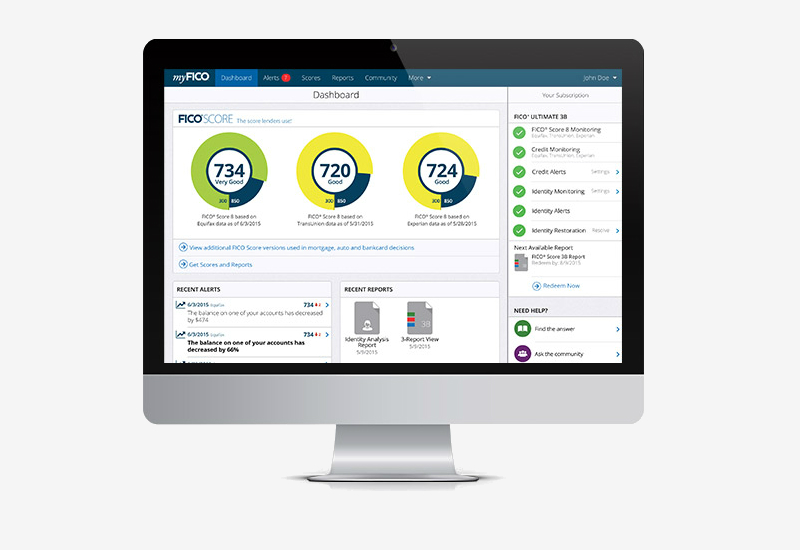What is Your FICO Credit Score?
The higher your FICO score is the more likely you will be able to obtain the best interest rates, discounts, and other perks when applying for a loan.
There are five main factors that go into making up your total FICO score, with various amounts of impact. They are:
FICO Credit Score Factors and Their Percentages
| FICO credit score factors | Percentage weight on credit score: | What it means: |
|---|---|---|
| Payment history | 35% | Your track record when it comes to making (at least) the minimum payment by the due date. |
| Amounts owed | 30% | How much of your borrowing potential is actually being used. Determined by dividing total debt by total credit limits. |
| Length of credit history | 15% | The average age of your active credit lines. Longer histories tend to show responsibility with credit. |
| Credit mix | 10% | The different types of active credit lines that you handle (e.g., mortgage, credit cards, students loans, etc.) |
| New credit | 10% | The new lines of credit that you’ve requested. New credit applications tend to hurt you score temporarily. Learn more about FICO credit score |
As your credit information changes so will your FICO score, which will be reflected in your overall credit history.
If you’re trying to improve your credit score, you’ll want to consider all of these factors and the parts they play in your credit profile.
Unfortunately, FICO does not reveal the formulas used to generate its credit scores. Otherwise, it would be easy for the public to game.
Variations of the FICO Score

There are three main credit bureaus that track your credit history. Credit scores are commonly calculated based on the data on your credit reports. They are Transunion, Experian, and Equifax.
It gets worse and more confusing:
Many companies, including the credit bureaus, use different scoring models to create credit scores that show how trustworthy you are with borrowed funds.
Variations of the FICO Score include the FICO Score 2, FICO Score 3, FICO Score 5, FICO Score 8, and FICO Score 9.
There are additional variations based on specific loans, like auto financing, that may use another variation of the FICO Score not listed here.
The main reason for the FICO score variations is that the FICO score algorithm is constantly being updated to reflect creditworthiness as accurately as possible.
This results in a new version of the score being released every couple of years. The most recent score that’s widely used and accepted by most lenders and all three credit bureaus is the FICO Score 8.
Also, there may be different credit scores for different purposes, such as auto-lending or apartment renting.
So:
How to Find Your Score
In order to accurately record your credit history and analyze your information to create a FICO score, you need one account that’s been open and actively reported to a credit bureau within the last six months.
Otherwise, there won’t be enough information to calculate your FICO score.
You do not need to borrow a large amount of debt in order to have a FICO score.
You can simply have a statement balance that shows up on your account. This can be in the form of charging money to a credit card and paying off the entire balance at the end of each month.
To check your own credit score, you have many options. Generally, you can pay for a one-time credit score or a subscription service directly through FICO.
However, that can get expensive. Banks and credit card companies may offer free monthly FICO credit scores.
Credit Score Ranges and Quality
| Credit Score Ranges | Credit Quality | Effect on Ability to Obtain Loans |
|---|---|---|
| 300-580 | Very Bad | Extremely difficult to obtain traditional loans and line of credit. Advised to use secured credit cards and loans to help rebuild credit. |
| 580-669 | Bad | May be able to qualify for some loans and lines of credit, but the interest rates are likely to be high. |
| 670-739 | Average/Fair | Eligible for many traditional loans, but the interest rates and terms may not be the best. |
| 740-799 | Good | Valuable benefits come in the form of loans and lines of credit with comprehensive perks and low interest rates. |
| 800-850 | Excellent | Qualify easily for most loans and lines of credit with low interest rates and favorable terms. |
A New FICO Score is Changing the Future
The FICO Score XD has been developed as a new scoring model designed to calculate scores based on additional factors (aside from the five listed above) like paying your cell phone or electricity bills on time.
This new score aims to help lenders assess an individual’s credit rating who may not have a strong traditional credit history, but instead has a strong profile of paying bills and other obligations on time.
If you’ve struggled with being approved for credit or loans in the past, the FICO XD uses alternative history and data to determine your creditworthiness and may help you have more successful credit applications in the future.
While the FICO XD is still a work-in-progress be on the lookout for a new way to apply for credit using alternative methods and payment history as a way to establish your risk profile to potential lenders.
What’s the bottom line?
To build a good history of credit it’s important to stay on top of all your bills and regularly check your credit report for errors and other red flags.
There are a couple quick fixes to improve your credit, but you’ll still need to be patient and continue managing your money as responsibly as possible.
Before you know it, you’ll be in a great position to qualify for the best credit cards and the lowest interest rates on major loans.

